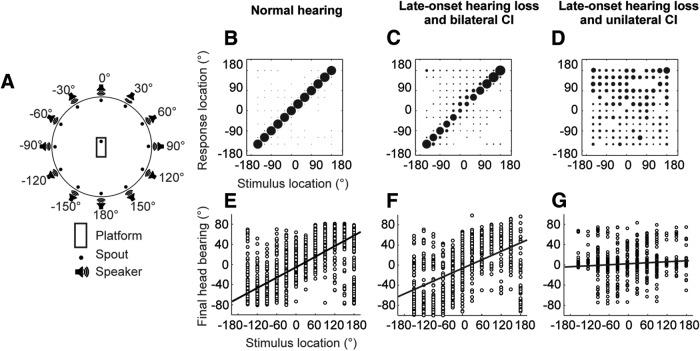Figure 4.
Sound localization after unilateral or bilateral cochlear implantation in ferrets that were deafened in adulthood. A, Testing chamber with 12 loudspeakers arranged circumferentially. A trial was initiated when the animal mounted the central platform and licked the start spout; a fluid reward was provided if the animal then approached and licked the spout adjacent to the loudspeaker from which the stimulus had been presented. B–D, Stimulus–response plots for ferrets with NH (B, n = 4), and in animals with late-onset hearing loss and either BiCIs (C, n = 2) or a UniCI (D, n = 2). The stimuli were broadband noise bursts with a duration of 2000 ms. The size of the dots indicates the proportion of responses made to each loudspeaker location. Although a clear correlation between the stimulus and response locations was observed for the control and bilaterally implanted ferrets, this was not the case for the animals with a CI in one ear only (F(2,72) = 47.24, p < 0.001, ANOVA; post hoc comparisons revealed significant differences between each group, p < 0.001). E–G, Stimulus–response plots showing the distribution of final head bearings as a function of stimulus location, for NH animals (E) and those with late-onset hearing loss and BiCIs (F) or a UniCI (G). Significant group differences in the slopes of the best-fitting linear regressions were found for these head-orienting data (F(2,5693) = 8.03, p < 0.001; ANOVA). Post hoc comparisons showed that all slopes were significantly different from each other (p < 0.001) and, importantly, that the slope of the regression line fitted to the head-orienting data from the UniCI animals was not significantly different from zero (p = 0.16), indicating that these animals were unable to localize these sounds.

